work in progress
Continuation of the From Scratch cycle
25 09 25
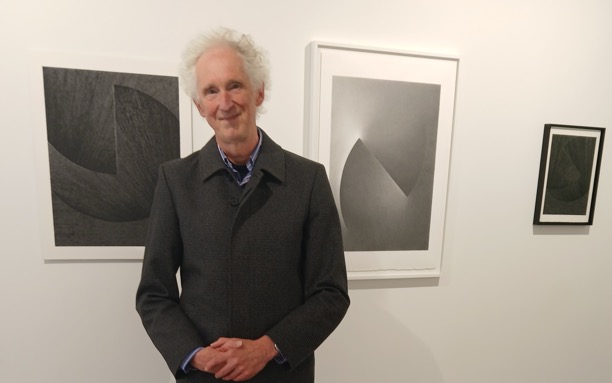
This fall, I began work on the third and final part of the From Scratch Cycle. From Scratch is based on drawings by visual artist Alexandra Roozen. As the title suggests, I'm building the music from the ground up, closely following Roozen's working method rather than the feelings her work evokes in me.
The first part of the cycle, From Scratch I, ›Plain Dust‹ & ›Trills‹, was performed in 2019 by the Ives Ensemble at the November Music Festival and the Muziekgebouw, Amsterdam.
From Scratch II, ›Seen by Hand‹, was completed in 2020 but not performed due to the coronavirus epidemic.
In 2013, Alexandra exhibited the series of drawings ›Traces‹ in Seoul, which is based on the instructions for the musicians in the score of From Scratch I.
For From Scratch III, I'm basing my work on her most recent series of drawings: ›Surround‹ & ›Black Ice‹, a glimpse of which can be seen in the photo (Gallery Roger Katwijk).
Genieting VIII for violin will be premiered in 2025 by violinist Janneke van Prooijen
02 01 25
»A half moon shines south and east of Europe, from Andalusia via North Africa and Turkey to the Balkans. Its light penetrates into Western Europe, and here, in this nightly light, I hear the contours of music that is strange to me but nevertheless deeply touches me. I capture its sound rays in Genieting VIII for solo violin.« (Willem Boogman)

flyer by Egbert Luijs
Composer Willem Boogman selected some forty melodies from classical Turkish art music, folk music from the Balkan countries, classical Arabic-Andalusian music and flamenco. The connecting link is a system of pitch intervals, the Turkish mode Hicaz, which is related to the Arabic Hijas and the Western Phrygian mode. It is these modes that give the music a specific colour. He uses the melodic, harmonic, rhythmic and metric contours of these melodies as building blocks for his musical forms.
Musical forms rarely retain their identity in Boogman's music: they are recognisable, but also distinctly fluid. They appear, like clouds in the sky, ever changing in shape in an ever changing light, evaporating and penetrating each other, taking on each other's characteristics.

flyer by Egbert Luijs
Composer Willem Boogman selected some forty melodies from classical Turkish art music, folk music from the Balkan countries, classical Arabic-Andalusian music and flamenco. The connecting link is a system of pitch intervals, the Turkish mode Hicaz, which is related to the Arabic Hijas and the Western Phrygian mode. It is these modes that give the music a specific colour. He uses the melodic, harmonic, rhythmic and metric contours of these melodies as building blocks for his musical forms.
Musical forms rarely retain their identity in Boogman's music: they are recognisable, but also distinctly fluid. They appear, like clouds in the sky, ever changing in shape in an ever changing light, evaporating and penetrating each other, taking on each other's characteristics.
Preparing Genieting VIII for violin
31 01 24

Tree of Modes, the classical classification of the modes of Andalusian music, excerpted from the manuscript al-Haiek from the library Daúd in Tetuán.
Een oog in zee - preview of a music-theater work in progress
30 09 21

September 30 | 18:30 & 20:00
As part of the ›Sprekend Lichaam‹ [›Speaking Body‹] exhibition by visual artist Salomé Roodenburg in Factor IJ in Amsterdam, a performance of ›Een oog in zee‹ [›An eye in the sea‹] will take place on 30 September, the music-theater work in progress, for which Salomé wrote the libretto. Amidst the exhibited work, which, like the libretto, is inspired by the myth of Ariadne, we give a preview of the music-theater work that will be premiered in the spring of 2022 and for which I am composing the music.
›Een oog in zee‹ is a modern adaptation of the Greek tragedy of Ariadne, performed by a Helena van Heel - mezzo-soprano, Vincent van Amsterdam - accordion, Fokke van Heel - horns and Kenzo Kusuda - performer.
The musicians act on stage and a world can be gained here if, as we do, you develop music-theater from and with the instrumentalists on stage, each of whom is a musical character.
Also with Salomé Roodenburg - libretto and stage design, Zephyr Brüggen - direction, and Stichting Noorderklank - production.
A grant for ›Een oog in zee‹!
08 11 20
Very happy with a grant from the Performing Arts Fund NL that makes it possible that, after a long period of preparations, I can start composing the new music theater work ›Een oog in zee‹, commissioned by Foundation Noorderklank! I feel privileged to work in a great team of fantastic and inspiring people: Salomé Roodenburg - libretto and scenography, Helena van Heel - mezzo-soprano, Vincent van Amsterdam - accordion, Fokke van Heel - horns, Kenzo Kusuda - dance, Zephyr Brüggen - stage direction, Nanny Roed Lauridsen - production. ›Een oog in zee› is based on the myth of Ariadne and Theseus, which we'll present in a new interpretation.

Painting: Salomé Roodenburg

Painting: Salomé Roodenburg
Een oog in zee
05 07 20
In preparation: the music theater performance ›Een oog in zee‹ for which I'll write the music. This is the trailer that hopefully opens doors to many performances at various venues (season 2021-2022), and reasonable honoraria for all participants. I'm really looking forward to it!
Stichting Noorderklank presenteert: "Een oog in zee" - seizoen 2021/2022 from Stichting Noorderklank on Vimeo.
teaching composition, orchestration...
28 01 20
I intend to expand my teaching practice in composition, orchestration / instrumentation and making arrangements. There is room for one or two more students.
If you want to be taught on these subjects, or improve your skills in these areas, then contact me, or take a look at my website: teaching
What I have to offer is certainly also fit for those who for some reason cannot attend the conservatory.
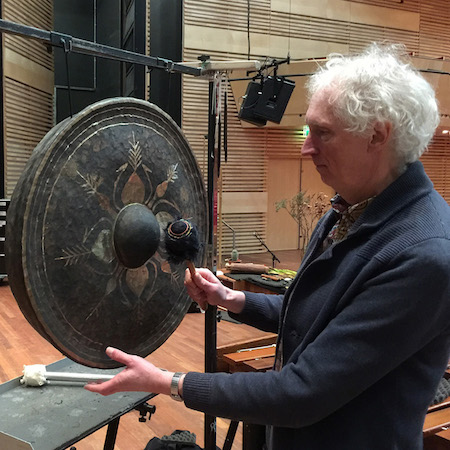
Photo: Alexandra Roozen
If you want to be taught on these subjects, or improve your skills in these areas, then contact me, or take a look at my website: teaching
What I have to offer is certainly also fit for those who for some reason cannot attend the conservatory.

Photo: Alexandra Roozen
Werkbericht
26 04 16
Ik heb een uitermate elegante en inspirerende compositie-techniek te pakken, gebaseerd op een theorie van Stockhausen (›polyparametriek‹).
Het lijkt in de verte ook op Ableton, maar ik maak geen gebruik van het programma.
Het werk vindt plaats in de innerlijke wereld van bestaande of gefixeerde muziek. Met de techniek en wat voorstellingsvermogen kan ik het muzikale DNA zodanig veranderen dat het weefsel een gedaantewisseling ondergaat. Er ontstaat tegelijkertijd ›diepte‹, een soort meer-dimensionaliteit, of een ›verwijde‹ polyfonie, in klank!
De volledige techniek pas ik nu toe in Distant Voices voor acht muzikanten.
De techniek werd ›voorbereid‹ met Genieting VII voor piano (helaas nog onvoltooid wegens gebrek aan tijd en geld) en Nous le chant III voor kamerkoor, accordeon, orgel en samples.
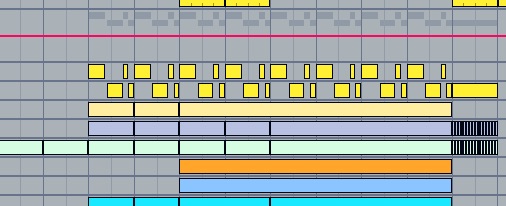
I have found a very elegant and inspiring composition technique, based on a theory of Stockhausen (›polyparametrics‹).
It also looks somewhat like Ableton, but I do not use the program.
The work takes place in the inner world of existing or fixated music. With the technique and some imagination I can change the musical DNA such that the fabric undergoes a metamorphosis. At the same time it creates ›depth‹, a kind of multi-dimensionality, or ›widened‹ polyphony, in sound!
The complete technique I now apply to Distant Voices for eight musicians.
The technique was ›prepared‹ with Genieting VII for piano (unfortunately unfinished because of lack of time and money) and Nous le chant III for chamber choir, accordion, organ and samples.
Het lijkt in de verte ook op Ableton, maar ik maak geen gebruik van het programma.
Het werk vindt plaats in de innerlijke wereld van bestaande of gefixeerde muziek. Met de techniek en wat voorstellingsvermogen kan ik het muzikale DNA zodanig veranderen dat het weefsel een gedaantewisseling ondergaat. Er ontstaat tegelijkertijd ›diepte‹, een soort meer-dimensionaliteit, of een ›verwijde‹ polyfonie, in klank!
De volledige techniek pas ik nu toe in Distant Voices voor acht muzikanten.
De techniek werd ›voorbereid‹ met Genieting VII voor piano (helaas nog onvoltooid wegens gebrek aan tijd en geld) en Nous le chant III voor kamerkoor, accordeon, orgel en samples.
I have found a very elegant and inspiring composition technique, based on a theory of Stockhausen (›polyparametrics‹).
It also looks somewhat like Ableton, but I do not use the program.
The work takes place in the inner world of existing or fixated music. With the technique and some imagination I can change the musical DNA such that the fabric undergoes a metamorphosis. At the same time it creates ›depth‹, a kind of multi-dimensionality, or ›widened‹ polyphony, in sound!
The complete technique I now apply to Distant Voices for eight musicians.
The technique was ›prepared‹ with Genieting VII for piano (unfortunately unfinished because of lack of time and money) and Nous le chant III for chamber choir, accordion, organ and samples.
Werkbericht
20 10 15
Vandaag bevind ik me op een kruispunt: het werk aan Genieting VII voor piano wordt doorkruist door het begin van het werk aan ›Distant Voices‹ (voorlopige titel) voor het Spectra Ensemble.
In meerdere opzichten is het een kruispunt: Genieting VII is gebaseerd op de pianosonate DV 894 van Schubert (met name in de zeer langzame uitvoering van Svjatoslav Richter) en ›Distant Voices‹ op de mis ›Maria Zart‹ van Obrecht.
In Genieting VII benader ik de muziek van Schubert via een spectrum op de toon G. In deze spectraliteit wil ik een soort afdruk maken van het eerste deel van de sonate, waarover ik vervolgens ook mijn muzikale fantasie laat gaan.
In ›Distant Voices‹ hanteer ik de werkmethode van Obrecht (en tal van tijdgenoten) om een of meerdere chansons (populaire melodieën) als uitgangspunt te nemen voor de cantus firmus van de mis. Ik kies daarvoor een aantal gitaarriffs uit de popmuziek. Verder wil ik proberen de structuur van de compositie te baseren op de getalstructuur die ten grondslag ligt aan Obrechts mis ›Maria Zart‹, zoals beschreven door M. van Crevel in zijn editie van het werk.
.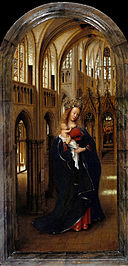
Today I find myself at a crossroads: the work on Genieting VII for piano is intersected by starting the work on ›Distant Voices‹ (working title) for Spectra Ensemble.
In several ways, it is a crossroads: Genieting VII is based on piano sonata DV 894 by Schubert (in particular in the very slow performance of Sviatoslav Richter) and ›Distant Voices‹ on the Mass ›Maria Zart‹ by Obrecht.
In Genieting VII I approach Schubert’s music via a spectrum of the tone G. In this spectrality I want to make a kind of imprint of the first movement of the sonata, to which I then also fantasize musically.
In ›Distant Voices‹ I adopt the working method of Obrecht (and many of his contemporaries) to use one or more chansons (popular songs) as a starting point for the cantus firmus of the Mass. For this purpose I choose some guitar riffs from pop music. I also want to try to base the structure of the composition on the numerical structure that underlies Obrecht’s Mass ›Maria Zart‹ as described by M. van Crevel in his edition of the work.
In meerdere opzichten is het een kruispunt: Genieting VII is gebaseerd op de pianosonate DV 894 van Schubert (met name in de zeer langzame uitvoering van Svjatoslav Richter) en ›Distant Voices‹ op de mis ›Maria Zart‹ van Obrecht.
In Genieting VII benader ik de muziek van Schubert via een spectrum op de toon G. In deze spectraliteit wil ik een soort afdruk maken van het eerste deel van de sonate, waarover ik vervolgens ook mijn muzikale fantasie laat gaan.
In ›Distant Voices‹ hanteer ik de werkmethode van Obrecht (en tal van tijdgenoten) om een of meerdere chansons (populaire melodieën) als uitgangspunt te nemen voor de cantus firmus van de mis. Ik kies daarvoor een aantal gitaarriffs uit de popmuziek. Verder wil ik proberen de structuur van de compositie te baseren op de getalstructuur die ten grondslag ligt aan Obrechts mis ›Maria Zart‹, zoals beschreven door M. van Crevel in zijn editie van het werk.
.
Today I find myself at a crossroads: the work on Genieting VII for piano is intersected by starting the work on ›Distant Voices‹ (working title) for Spectra Ensemble.
In several ways, it is a crossroads: Genieting VII is based on piano sonata DV 894 by Schubert (in particular in the very slow performance of Sviatoslav Richter) and ›Distant Voices‹ on the Mass ›Maria Zart‹ by Obrecht.
In Genieting VII I approach Schubert’s music via a spectrum of the tone G. In this spectrality I want to make a kind of imprint of the first movement of the sonata, to which I then also fantasize musically.
In ›Distant Voices‹ I adopt the working method of Obrecht (and many of his contemporaries) to use one or more chansons (popular songs) as a starting point for the cantus firmus of the Mass. For this purpose I choose some guitar riffs from pop music. I also want to try to base the structure of the composition on the numerical structure that underlies Obrecht’s Mass ›Maria Zart‹ as described by M. van Crevel in his edition of the work.
Raving
24 01 13
At the moment I am working on my first orchestral work: ›Raving, for large orchestra and electronic dance pulses‹, commissioned by the ZaterdagMatinee. The performance is scheduled for February 01/02/ 2014 at the Concertgebouw in Amsterdam, at 14:00. The Netherlands Radio Philharmonic Orchestra will be playing under the direction of Reinbert de Leeuw.

Sandra Macrander took new pictures of me which I will post soon on my website. This is one of them, which is also shown in the season 2013-2014-brochure of the ZaterdagMatinee.
Sandra Macrander took new pictures of me which I will post soon on my website. This is one of them, which is also shown in the season 2013-2014-brochure of the ZaterdagMatinee.
Genieting V
10 07 11
On my desk lies One Noon for six spatially-positioned percussionists. I still have to write about 5 minutes of music to complete the score. However, I have interrupted this work for composing Genieting V for accordion, creating a new ›Genieting‹ that may be added to the series of solo pieces under that title.
Genieting V was commissioned by the accordionist Vincent van Amsterdam, whom I met at the rehearsals and performances of The Hours 7-11, as one of the musicians of f.c. jongbloed.
Solo works, by and large, emphasize the player’s technical mastery of the instrument and challenge the limits of the achievable. In the series of solo works under the title ›Genieting‹ this aspect is characterized by the duality of the performer who takes control of the physical characteristics of his instrument but at the same time is submerged in them: an elementary world that also remains strange and ›foreign‹ for the player as well as the listener.
Genieting V was commissioned by the accordionist Vincent van Amsterdam, whom I met at the rehearsals and performances of The Hours 7-11, as one of the musicians of f.c. jongbloed.
Solo works, by and large, emphasize the player’s technical mastery of the instrument and challenge the limits of the achievable. In the series of solo works under the title ›Genieting‹ this aspect is characterized by the duality of the performer who takes control of the physical characteristics of his instrument but at the same time is submerged in them: an elementary world that also remains strange and ›foreign‹ for the player as well as the listener.
Day Daily - The Hours
26 03 11
f.c. jongbloed heeft zich opnieuw geformeerd onder leiding van Arnold Marinissen om binnenkort het programma ›uitkleden, aankleden‹ uit te voeren. Zie agenda. Ik schrijf voor hen De Uren 7-11, de laatste, nog ontbrekende set van de cyclus Dag Dagelijks — De Uren. De Uren 7 -11 zijn vijf stukken van één minuut die de ochtend representeren. De bezetting bestaat opnieuw uit vier spelers: trompet, cello, elektrische gitaar en accordeon. En als het meezit zal de elektronische puls weer door de ruimte gedragen worden.
De ochtend vangt de nacht op bij het eerste schijnsel van de dag die gedurende de uren 7 tot en met 11 tot volle wasdom komt, met als hoogtepunt het middaguur, als de zon op zijn hoogste punt staat.
Het vijftonige basisakkoord, dat aan de hele cyclus ten grondslag ligt, wordt eerst omhuld door grote drieklanken - een residu van De Dag Daagt voor orgel (Uur 6) dat bestaat uit kleine drieklanken, maar is geëindigd met één grote, op A.
Geleidelijk verdwijnen de drieklanken zodat het eigenlijke basisakkoord zich toont.
Met het gereedkomen van de ochtenduren krijgt de betekenis van de cyclus het laatste zetje om zich nu helemaal te ontvouwen. Dat maakt het werken hieraan extra spannend! Overigens kunnen de vier sets Uren ook heel goed apart uitgevoerd worden. Zie werkenlijst.

De ochtend vangt de nacht op bij het eerste schijnsel van de dag die gedurende de uren 7 tot en met 11 tot volle wasdom komt, met als hoogtepunt het middaguur, als de zon op zijn hoogste punt staat.
Het vijftonige basisakkoord, dat aan de hele cyclus ten grondslag ligt, wordt eerst omhuld door grote drieklanken - een residu van De Dag Daagt voor orgel (Uur 6) dat bestaat uit kleine drieklanken, maar is geëindigd met één grote, op A.
Geleidelijk verdwijnen de drieklanken zodat het eigenlijke basisakkoord zich toont.
Met het gereedkomen van de ochtenduren krijgt de betekenis van de cyclus het laatste zetje om zich nu helemaal te ontvouwen. Dat maakt het werken hieraan extra spannend! Overigens kunnen de vier sets Uren ook heel goed apart uitgevoerd worden. Zie werkenlijst.

De Dag Daagt
12 05 10
Twilight: a liminal stage
The part of the cycle ›Day Daily‹ that was composed first was the midnight music Nous le chant I & II (2009).
Then the five hours of the evening Day Daily – The Hours 19-23 were completed and performed in November 2009. I couldn't finish ›Hour 23‹ in time for the performance, and that's why you will not find the recording of this one-minute piece on this website.
In March 2010 the nocturnal hours Day Daily – The Hours 1-5 were completed and performed.
Currently I am working on the music that deals with the morning twilight, the time between dawn and sunrise. It is entitled ›De Dag Daagt‹ [The Day Dawns] and is a composition for pipe organ commissioned by Johan Luijmes, artistic director of the Orgelpark in Amsterdam.
The afternoon hours 13-17 are scheduled for the autumn, and the morning hours 7-11 for the spring 2011. Both sets, each of them with an unique scoring, will again be performed by f.c. jongbloed & Arnold Marinissen - conductor.
For an overview of the cycle on which I will also be working the coming years, see: Day Daily (weblog category: work in progress)
Recently the book entitled ›Sluiproutes en dwaalwegen‹ [Shortcuts and false scents] (1991) by Anthony Mertens impressed me very much. It deals with liminal poetics and it gives an excellent overview and definitions of liminality, a concept that perhaps best characterizes my music. The adjective ›liminal‹ derives from the Latin name for threshold, ›limen‹. Twilight is a typical example of a liminal stage of the day. I will write more about this issue in this weblog.
Protesilaos & Laodamia
28 11 09
Recently I completed a drastic revison of my arrangement and scoring of Rudolf Escher’s short opera Protesilaos and Laodamia.
Rudolf Escher (1912-1980) wrote this opera [›Zangspel‹] extremely fast in 1946 and left it unorchestrated.
In 1990 the Rudolf Escher Committee commissioned my arrangement and scoring of the work. It was performed in March 2004 by the Radio Chamber Orchestra conducted by Otto Tausk in the Concertgebouw, Amsterdam (ZaterdagMatinee).
 The text by Martinus Nijhoff is based on the story of Protesilaos, the first Greek warrior who was killed in the Troian war. Ten years after his dead Protesiloas was allowed by the Gods to return for one day to his wive Laodamia, accompanied by Hermes. At the end of the day Protesilaos has to return to the World of the Death. With the help of Hermes, having pity on her, Laodamia follows Protesilaos into the underworld, disguised as Hermes. Hermes takes up a living as a shepherd in Thessaly, something Escher probably would have done himself. Then most of his music is inspired by an idealized Mediterranean landscape and atmosphere.
The text by Martinus Nijhoff is based on the story of Protesilaos, the first Greek warrior who was killed in the Troian war. Ten years after his dead Protesiloas was allowed by the Gods to return for one day to his wive Laodamia, accompanied by Hermes. At the end of the day Protesilaos has to return to the World of the Death. With the help of Hermes, having pity on her, Laodamia follows Protesilaos into the underworld, disguised as Hermes. Hermes takes up a living as a shepherd in Thessaly, something Escher probably would have done himself. Then most of his music is inspired by an idealized Mediterranean landscape and atmosphere.
In Protesilaos and Laodamia the impact of Mahler’s music on Escher is clearly present. That may be important for the general perception of his music.
The coin represents Protesilaos descending from the ship, ready to meet his fate. Thessaly, Thebai. Ca 302-286 BC. (Image courtesy of Gorny & Mosch)
Rudolf Escher (1912-1980) wrote this opera [›Zangspel‹] extremely fast in 1946 and left it unorchestrated.
In 1990 the Rudolf Escher Committee commissioned my arrangement and scoring of the work. It was performed in March 2004 by the Radio Chamber Orchestra conducted by Otto Tausk in the Concertgebouw, Amsterdam (ZaterdagMatinee).
In Protesilaos and Laodamia the impact of Mahler’s music on Escher is clearly present. That may be important for the general perception of his music.
The coin represents Protesilaos descending from the ship, ready to meet his fate. Thessaly, Thebai. Ca 302-286 BC. (Image courtesy of Gorny & Mosch)
Day Daily
21 05 09
I am working on a new project: the cycle Day Daily [Dag Dagelijks]. As in my earlier cycles I systematically bring up the elementary world of sound and music, usually connected with a specific, extramusical reality. Day Daily is inspired by literary, scientific and everyday interpretations of the day, and especially by phenomenological research on this topic by philosopher Chris Bremmers.
With Day Daily I want to recall the day to us, or at least the memory of that one Day amidst all days. I would also like to develop certain aspects of my music further, which is sound transmitted in space, different scorings within a piece and compositional / musical elements being in a permanent transition (liminality).
Day Daily consists of four long pieces of approximately 15-20 minutes, composed for the transitory moments of the day: midnight, daybreak, midday and nightfall. These transitory moments are linked with each other by twenty one-minute pieces, which stand for the hours of the day.
The parts of the cycle can be performed both independently and integral.
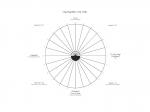
The midnight part, entitled: ›Nous le chant‹, forms a small cycle within the large one, and contains five vocal pieces on texts of the French poet Henri Meschonnic. From his collection of poems ›Nous le passage‹ I selected:
1. aujourd’hui nous
2. on s’entend c’est la lumière
3. la lumière amoureuse
4. la nuit luit
5. un jour et je suis ce jour
The first three are composed for five singers of Schola Heidelberg (SSATB) and a trio of ensemble aisthesis (clarinet, piano and percussion) at the request of KlangForum Heidelberg (D) and Walter Nußbaum – conductor.
With Day Daily I want to recall the day to us, or at least the memory of that one Day amidst all days. I would also like to develop certain aspects of my music further, which is sound transmitted in space, different scorings within a piece and compositional / musical elements being in a permanent transition (liminality).
Day Daily consists of four long pieces of approximately 15-20 minutes, composed for the transitory moments of the day: midnight, daybreak, midday and nightfall. These transitory moments are linked with each other by twenty one-minute pieces, which stand for the hours of the day.
The parts of the cycle can be performed both independently and integral.
Click here for an overview of the cycle
The midnight part, entitled: ›Nous le chant‹, forms a small cycle within the large one, and contains five vocal pieces on texts of the French poet Henri Meschonnic. From his collection of poems ›Nous le passage‹ I selected:
1. aujourd’hui nous
2. on s’entend c’est la lumière
3. la lumière amoureuse
4. la nuit luit
5. un jour et je suis ce jour
The first three are composed for five singers of Schola Heidelberg (SSATB) and a trio of ensemble aisthesis (clarinet, piano and percussion) at the request of KlangForum Heidelberg (D) and Walter Nußbaum – conductor.
